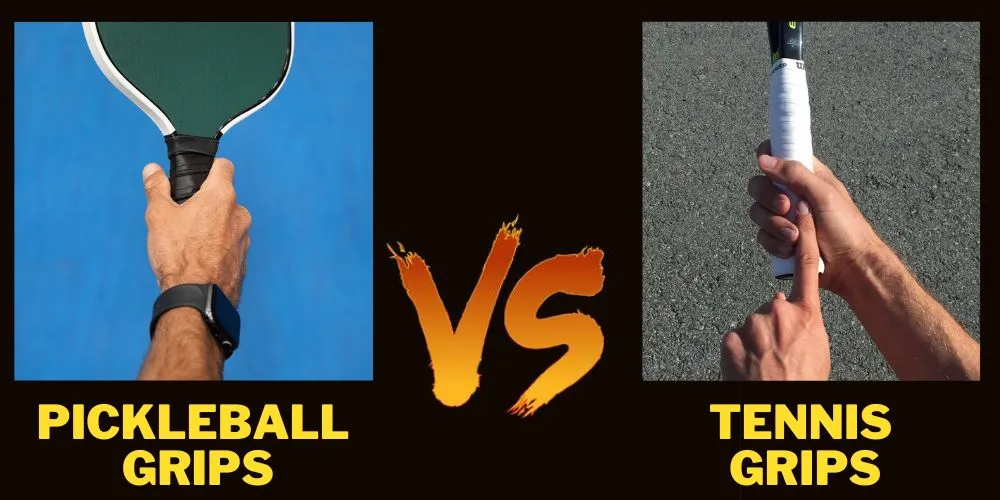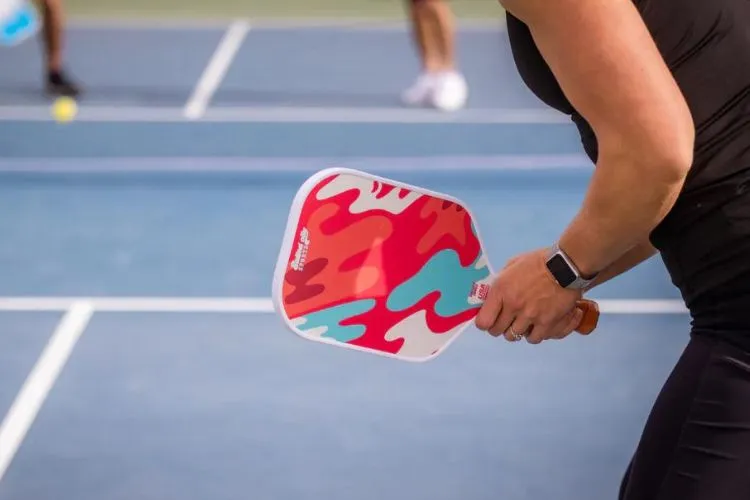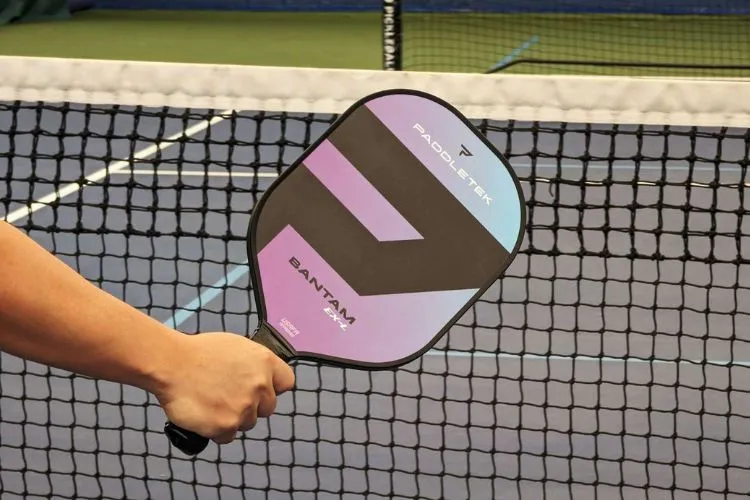When it comes to racket sports, grip techniques play a crucial role in a player’s performance. As pickleball continues to gain popularity, many enthusiasts coming from tennis backgrounds can find it challenging to adapt to a new grip.
In this article, we’ll delve into the key differences and advantages of pickleball grips vs tennis grips, helping both beginners and experienced players understand the nuances and improve their game on the court.

Pickleball Grips vs Tennis Grips: A Detailed Comparison
In the world of racket sports, the way players hold their equipment can dramatically impact their performance. Pickleball and tennis, while similar, require two distinct grip styles that cater to their unique play requirements.
The most significant difference lies in the size and changeability of the grip. Tennis favors stability with larger, more static grips, while pickleball demands adaptability with smaller, rapidly changing grips. This article offers a comprehensive exploration of these nuances.
Grip Size
Pickleball Grips:
Pickleball paddle handles generally have a circumference ranging from 4 to 4.5 inches. This smaller grip size allows for better wrist action and quick changes in grip during play, which is essential for dinks and soft touch shots in pickleball.
Tennis Grips:
Tennis racket handles are typically larger than those of pickleball paddles, with circumferences varying between 4 1/8 to 4 5/8 inches. The larger grip sizes provide better leverage for more powerful swings and control in tennis.
Grip Types
Pickleball Grips:
- Eastern Grip: Suitable for beginners as it offers a comfortable grip for dinks and shallow shots.
- Continental Grip: Most commonly used in pickleball, providing versatility for various shots and offering better control.
Tennis Grips:
- Eastern Grip: Foundational grip used for forehand groundstrokes.
- Western Grip: Allows for increased topspin and preferred by aggressive baseline players.
- Continental Grip: Versatile and used for serves, volleys, and backhands.
- Semi-Western Grip: Offers a balance between power and control for groundstrokes.
Grip Changes
Pickleball Grips:
In pickleball, players may quickly change grips to achieve better control and finesse for specific shots like dinks, drops, and volleys. This requires a more fluid approach to gripping the paddle.
Tennis Grips:
Tennis players often maintain a consistent grip throughout play. However, some advanced players may adjust their grip slightly between forehand and backhand strokes to maximize their swings’ power and control.
Grip Pressure
Pickleball Grips:
A light grip pressure is recommended for pickleball, as it allows for more wrist movement and quick paddle adjustments. This is vital for executing quick shots or soft touches just over the net.
Tennis Grips:
Tennis players tend to exert a tighter grip on their rackets, as it provides more stability and control when slamming powerful strokes. However, players must still find a balance to avoid over-gripping, which may limit wrist movement and cause strain injuries.
In conclusion, understanding and adapting to the distinct differences in pickleball and tennis grips can help enhance your performance and ensure a smooth transition if you’re switching between these sports.
Sure, I’ll create a textual representation of a comparison chart. Please note that this chart illustrates general ranges and may vary between brands and player preferences.
Pickleball vs tennis grips size chart
| Pickleball Grips | Tennis Grips | |
| Average Circumference | 4-4.5 inches | 4 1/8 – 4 5/8 inches |
| Type of Grips | – Eastern Grip <br/> – Continental Grip | – Eastern Grip <br/> – Western Grip <br/> – Continental Grip <br/> – Semi-Western Grip |
| Quick Grip Changes? | Yes, frequent changes offer better control for a variety of shots | Occasional changes between forehand and backhand strokes by advanced players only |
| Grip Pressure | Light grip pressure recommended for more wrist movement and quick paddle adjustments | Tighter grip pressure provides stability for powerful strokes, but excessive gripping can limit wrist movement and cause strain |
How to Choose a Pickleball Grip: A Comprehensive Guide
Selecting the right grip is an essential part of becoming an effective pickleball player. Here’s a guide on factors to consider and steps to help you choose the ideal pickleball grip.

Grip Type
Based on your level of play, choose between the following grip types:
- Eastern Grip: Best for beginners. This grip offers comfortable handling for dinks and shallow shots.
- Continental Grip: Most commonly used by pros. This grip provides better control and is versatile for various shots.
Grip Size
Choose the correct grip size based on your hand size. Here’s a quick guide:
- Test the grip: Hold the paddle naturally and assess the space between your fingers and the base of your thumb. If you can snugly fit your index finger of your other hand in this space, it’s a good fit.
- Use the height rule: As a general rule, players under 5’2″ might prefer a grip size of around 4″, players between 5’3″ and 5’8″ around 4 1/4″, and players 5’9″ and over around 4 1/2″. However, preferences can vary, so it’s best not to solely rely on this rule.
Grip Material
Grip materials can vary, including leather, rubber, and synthetic materials. Consider the following:
- Cushioning: A grip with extra cushioning can improve comfort and reduce hand fatigue.
- Absorbency: Choose a grip that absorbs sweat well, ensuring you can maintain a solid grasp even during long matches.
- Durability: Synthetic materials often provide good durability without peeling or tearing.
Grip Tackiness
Grip tackiness refers to how ‘sticky’ the grip feels. It’s a matter of personal preference:
- High Tackiness: Grips with high tackiness may allow for better control but can be difficult to adjust your hold quickly.
- Low Tackiness: Lower tackiness can be slicker, meaning quicker adjustments to the grip but possibly less stability.
Overgrip Consideration
Depending on your preference, you might want to add an overgrip to your paddle:
- Size Increase: Overgrip can slightly increase your grip’s diameter if you find it too small.
- Comfort Boost: They can also add extra cushioning and absorbency.
Test it Out
Finally, try out different grips and paddles whenever possible. Personal preference and comfort are key and can only be judged accurately by getting a feel for the equipment yourself.
Remember, the grip is your sole connection to your paddle, so taking the time to choose the right one can significantly enhance your performance on the court.
You may also fine useful: Continental vs Eastern Pickleball Grip
How to Increase Grip Size on a Pickleball Paddle: A Detailed Guide
If you’re finding that your pickleball paddle grip is too small for comfort, there are a few methods you can use to increase the size. Here’s a detailed guide to help you through the process:

Purchase an Overgrip
Overgrips are thin layers of material that you can wrap around your existing grip to slightly increase its size. They are inexpensive and straightforward to apply.
Steps:
- Remove your current overgrip if you have one.
- Starting at the base of the handle, wrap the overgrip around your paddle’s handle, moving upwards diagonally.
- Ensure each turn overlaps slightly with the previous.
- Secure the end with the included adhesive tape.
Note: Overgrips wear out faster than replacement grips due to their thinness. Replace when you notice a decrease in tackiness or absorbency.
Buy a Replacement Grip
A replacement grip is designed to replace your original grip, allowing for a more significant increase in grip size. They are thicker than an overgrip, thus they provide more padding and better shock absorption.
Steps:
- Peel off the old grip.
- Starting at the base of the handle, wrap the replacement grip around your paddle’s handle, ensuring each turn overlaps slightly.
- Secure the top end with the adhesive tape provided.
Note: Ensure to wrap tighter with the replacement grips compared to overgrips to avoid unnecessary bulkiness.
Heat Shrink Sleeve
Heat shrink sleeves are a more permanent solution to increase grip size. They are widely available online or at sports stores.
Steps:
- Remove the current grip.
- Slide the sleeve onto the handle.
- Use a heat gun (or hairdryer) to shrink the sleeve tightly onto the paddle handle.
- Once cooled, apply the new replacement grip or overgrip.
Note: Always secure the area you are working in and use the heat gun cautiously to avoid any accidents.
Each method will increase the size to a different extent, so it is crucial to try them out and find what suits you best. As a general rule, the optimal grip size allows for a finger’s width space between your fingers and palm when you grasp the handle.
Conclusion:
The grips in pickleball and tennis differ significantly in terms of size, type, pressure and adaptability. These variations directly correlate to the distinctive nature of each sport. Tennis demands power and stability, thus utilising larger, more static grips.
Conversely, pickleball requires agility and adaptability, prompting smaller, fluid grips. Navigating these disparities while transitioning between the sports can pose challenges.
However, understanding these grip differences can help one adapt quickly, enhancing their overall performance and gaming experience in both sports.

Pickleball’s more than a game to me—it’s a passion. I write, sharing its highs and lows, the thrills and the lessons. Some tales might draw you to the court, while others give a hint of the game’s magic. So, curious about my journey? Ready to dive deep into the world of pickleball with me? Let’s go.
